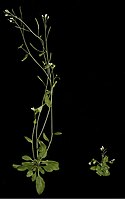
Photo from wikipedia
Self-incompatibility (SI) is a pollen-stigma recognition system controlled by a single and highly polymorphic genetic locus known as the S-locus. The S-locus exists in all Brassica napus (B. napus, AACC),… Click to show full abstract
Self-incompatibility (SI) is a pollen-stigma recognition system controlled by a single and highly polymorphic genetic locus known as the S-locus. The S-locus exists in all Brassica napus (B. napus, AACC), but natural B. napus accessions are self-compatible. About 100 and 50 S haplotypes exist in Brassica rapa (AA) and Brassica oleracea (CC), respectively. However, S haplotypes have not been detected in B. napus populations. In this study, we detected the S haplotype distribution in B. napus and ascertained the function of a common S haplotype BnS-6 through genetic transformation. BnS-1/BnS-6 and BnS-7/BnS-6 were the main S haplotypes in 523 B. napus cultivars and inbred lines. The expression of SRK in different S haplotypes was normal (the expression of SCR in the A subgenome affected the SI phenotype) while the expression of BnSCR-6 in the C subgenome had no correlation with the SI phenotype in B. napus. The BnSCR-6 protein in BnSCR-6 overexpressed lines was functional, but the self-compatibility of overexpressed lines did not change. The low expression of BnSCR-6 could be a reason for the inactivation of BnS-6 in the SI response of B. napus. This study lays a foundation for research on the self-compatibility mechanism and the SI-related breeding in B. napus.
Journal Title: Plants
Year Published: 2021
Link to full text (if available)
Share on Social Media: Sign Up to like & get
recommendations!